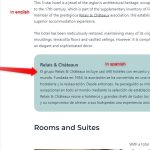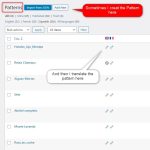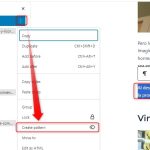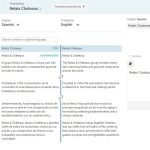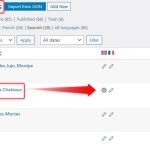This is the technical support forum for WPML - the multilingual WordPress plugin.
Everyone can read, but only WPML clients can post here. WPML team is replying on the forum 6 days per week, 22 hours per day.
Tagged: Not WPML issue
This topic contains 10 replies, has 2 voices.
Last updated by Nicolas V. 1 year, 9 months ago.
Assisted by: Nicolas V..
| Author | Posts |
|---|---|
| November 3, 2023 at 6:54 am #14722613 | |
|
diegoC-51 |
Hi, I'm reaching out because I've been experiencing a recurring issue, and I'd like to resolve it. The primary language of my page is Spanish, and I then translate it into English and French. I have patterns that are already translated. These patterns were created using the WordPress Editor and subsequently translated with the WPML Advanced Translator. When I create a post and have translated it into the two complementary languages, some patterns appear still in Spanish in the editor, but they display translated on the front end. I've attached images for a clearer understanding. Could you please assist me with this matter? |
| November 3, 2023 at 5:31 pm #14727779 | |
|
Nicolas V. Supporter
Languages: English (English ) French (Français ) Timezone: America/Lima (GMT-05:00) |
Hello, Welcome to the WPML support forum. Thanks for the screenshot, It makes it easier to understand. 1. First, I think that patterns are reusable blocks from Gutenberg. In that case, please make sure that you followed this documentation to translate them: https://wpml.org/documentation/getting-started-guide/translating-content-created-using-gutenberg-editor/translating-reusable-blocks/ They are considered as a separate post type to be translated (don't translate them inside the post itself). 2. Can you explain me your workflow to translate those pages? Because if you used WPML and our translation editor to translate those pages, you shouldn't open the translation in the WordPress editor. Switching between editors (our editor and WP editor) can create issues and lead to lose translations. |
| November 3, 2023 at 9:22 pm #14729185 | |
|
diegoC-51 |
Hi Nicolas, The strange thing is that the patterns are translated, but in the editor they appear not translated, while on the front end they do. Thank you for your help. |
| November 6, 2023 at 1:48 pm #14738505 | |
|
Nicolas V. Supporter
Languages: English (English ) French (Français ) Timezone: America/Lima (GMT-05:00) |
Hi, Thanks for the clarification on point #1. You're following the right workflow to translate those patterns. Now, could you please elaborate a little bit more on point #2. If you use our translation editor to translate your page from Spanish to English, then you shouldn't open the English translation in the WordPress editor. That's the part that confuse me a bit. Which editor do you use to translate the page? Our translation editor or WordPress? |
| November 6, 2023 at 2:23 pm #14738809 | |
|
diegoC-51 |
Hola Nicolas, |
| November 6, 2023 at 10:30 pm #14742377 | |
|
Nicolas V. Supporter
Languages: English (English ) French (Français ) Timezone: America/Lima (GMT-05:00) |
Hello again, Sorry if I didn't explain myself enough but there is a confusion here. The translation method for this pattern is correct.
Here I'm talking about the translation of the page that uses this pattern. If you used our translation editor or automatic translation to translate the page (that uses this pattern), then you shouldn't edit the English translation in the WordPress editor. I'm asking because on the very first screenshot you shared, I can see that you are editing an English page, in the WordPress editor. Maybe you could provide me a temporary access just to get to understand better the I will activate a private field for your next answer where you can provide that information safely (this field is only visible by you and the support team). Don't share your own admin account, create a new one that you will delete when we finish troubleshooting. IMPORTANT: Before we proceed, please backup your site and database. |
| November 7, 2023 at 5:17 pm #14750509 | |
|
Nicolas V. Supporter
Languages: English (English ) French (Français ) Timezone: America/Lima (GMT-05:00) |
Hi, Thank for the access but unfortunately, the credentials are incorrect:
But yes, once the translation has been made in our editor you shouldn't open the translation in the WordPress editor and make changes because if you update the original page and resave it, you "manual" translation in WP, will be overwritten by the translation in our editor. 1. If you want to edit links, by default, they are hidden in our editor. You can find them by using the search bar at the top left of the editor. If you search for "http" you will be able to see all outgoing links from that page. 2. If you edit the translation in the WP editor because you don't want the exact same layout/content then you should deactivate our editor. |
| November 8, 2023 at 1:36 pm #14757295 | |
|
Nicolas V. Supporter
Languages: English (English ) French (Français ) Timezone: America/Lima (GMT-05:00) |
Hello, Thanks for the access. I was able to see the issue. As I mentioned earlier, your patterns and pages are translated using our Advanced Translation Editor (ATE). It's not recommended to make changes directly in the WordPress editor because those changes will be overwritten by translations in ATE when you update the original page (please re-check that particular blog post to see if your changes are still there). Two things: 2. I've asked my colleagues from the second tier support if there was a way to improve the "experience" for you in the backend (even if we don't recommend the use of the WP editor). If I receive some feedback I'll let you know. |
| November 8, 2023 at 2:59 pm #14758133 | |
|
diegoC-51 |
Hello Nicolas, |
| November 9, 2023 at 1:03 pm #14767093 | |
|
Nicolas V. Supporter
Languages: English (English ) French (Français ) Timezone: America/Lima (GMT-05:00) |
Hello, Any time you can changes on the original page, you can re-validate the translation to keep it up-to-date. So if you're removing an element in Spanish, you only need to open the translation in ATE and click "Complete". And if you add an element that hasn't been translated yet, when you open ATE you will have to translate this new element in order to complete the translation. Now quick question, do you add / remove elements for all languages or on a specific language? I mean, do you add an element in Spanish and then always add it to the translations (English and French). Or do you have specific elements in French that don't exist in Spanish or English. In the last case, we're not talking about translation anymore but "localization", meaning that each language is different. And the workflow is different in that case. |
| November 9, 2023 at 1:14 pm #14767153 | |
|
Nicolas V. Supporter
Languages: English (English ) French (Français ) Timezone: America/Lima (GMT-05:00) |
Hi again, In order to save time, let me explain you the workflow in case you have different pages in FR and EN than the original ES. When you want different pages, it's not a "translation" any more. Our editor will only let you translate what's in Spanish, you can't add content or change layouts. In that case you have to translate manually, following this documentation: https://wpml.org/documentation/translating-your-contents/using-different-translation-editors-for-different-pages/ In short, you will deactivate ATE and work exclusively with the WordPress editor to translate your page. So at the moment you will add a pattern in your translation, because you're working on a French page, you will be offer to insert French versions of your pattern. To be honest I only recommend that option if you need different pages, because our editor comes with a lot of features that make the translation easier (like translation memory, autocorrect, easy HTML markers, glossary, etc...) |
| November 9, 2023 at 2:10 pm #14767923 | |
|
diegoC-51 |
Hello Nicolas, |

